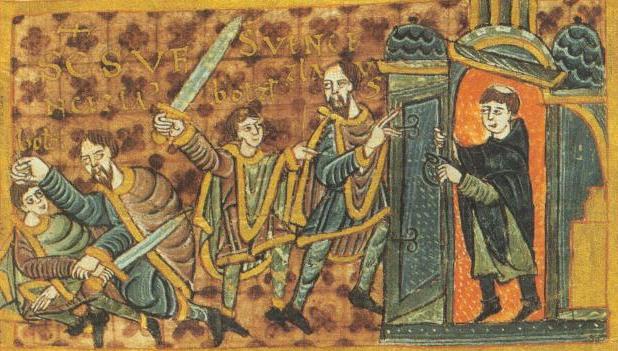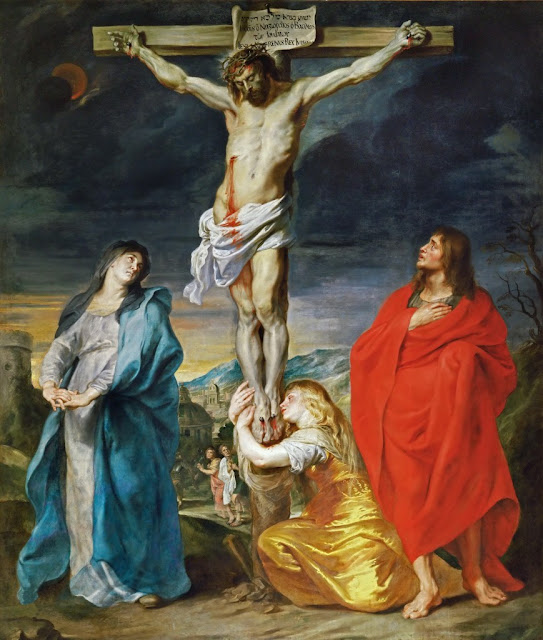Paolo Uccello, (1397–1475)
The Thébaïde, c. 1460s
Tempera on canvas
Height: 81 cm (31.8 in); Width: 110 cm (43.3 in)
Galleria dell'Accademia, Florence
The subject of this painting is rather unusual. In a rocky landscape with forests and caves populated by animals and monks engaged in a variety of activities. Such a composition does not adhere to any standardized iconography but appears to be a celebration of monasticism in general.
Paolo Uccello (1397 – 10 December 1475), born Paolo di Dono, was a Florentine painter and mathematician who was notable for his pioneering work on visual perspective in art. Uccello combined an International Gothic figure style and love of decorative effects with a profound interest in linear perspective, characteristic of the Early Renaissance. Both these features of his art are shown particularly clearly in 'The Battle of San Romano'.
Uccello was trained under the sculptor Ghiberti from about 1407 to 1414 and worked in Venice as a designer of mosaics (1425-30). A pioneer of studies in linear perspective, he executed major fresco commissions utilising the technique to different ends. The equestrian 'Sir John Hawkwood' in Florence Cathedral, (1436), manipulates perspective for the sake of illusionism; 'The Flood' in the cloister of Santa Maria Novella, (1447) uses it to enhance expression, probably under the influence of Donatello. His domestic decorations, however, devalue these effects by stressing colour and surface pattern. More on Paolo Uccello
Unknown artist
Venerable Zosimas and Sabbatius of Solovki
I have no further description, at this time
Saint Sabbatius lived for many years as a monk at the Monastery of St Cyril of White Lake, where his ascetic struggles won him the respect of his brethren. To flee from the admiration of men he moved further north to Valaam Monastery. But he still attracted the good opinion of his community, so he secretly headed still further north, planning to reach the uninhabited Solovki Island in the White Sea (a large bay of the Arctic Ocean). When he reached the coast, everyone who might take him tried to dissuade him from living in such a harsh place. He answered 'My children, I have a Master who has the power to renew the strength of the old and to enfeeble the young if He so wills. He makes the poor rich, clothes the naked, provides for the destitute and satisfies the starving with a measure of food as he fed five thousand men in the desert.'
The Boat Of Peter. Solovki, c. 2015
Oil on canvas
Lukash Anatoliy, born February 13 1956 in the village Povsten, Poltava region, Ukraine.
Graduated from Simferopol art school. Graduated from St. Petersburg State Academic Institute for Painting, Sculpture and Architecture. Member of the Russian Artists Union.
More on Lukash Anatoliy,
While waiting for seasonable sailing weather he met St Germanus (July 30) who lived nearby as a hermit. Together they found a fishing boat and, casting all their trust on the Lord, made the dangerous two-day voyage and set up a hermitage on the island.
Unknown artist
Saints Savvaty and Herman build a temple
Linden board, chalk gesso, tempera paints, varnish, 995 gold leaf
I have no further description, at this time
It became known as a holy place, and thenceforth those living in the world knew not to settle on Solovki, or even to set foot there without good reason. After six years, St Germanus departed, and Sabbatius was left alone.
Unknown artist
Sabbatius was left alone
I have no further description, at this time
When he was old, he began to fear that he would die without receiving the life-giving Mysteries, of which he had not partaken since he left Valaam. So he returned to the mainland where he met an abbot Nathanael just as he was taking Holy Communion to a sick man. Sabbatius persuaded the abbot to hear his confession and grant him the priceless gift of Holy Communion. He then settled in a nearby chapel and made ready for his departure from this life. A wealthy merchant from Novgorod visited him to ask for his blessing. The Saint said to him, 'Spend the night here and you will see the grace of God.' The next morning the merchant came to Sabbatius' cell and found that he had reposed during the night; his cell was suffused with a beautiful scent.
Unknown artist
Saints Zosima and Savvatij in a Russian icon from the early 18th century
I have no further description, at this time
The following year, St Germanus, along with St Zosimas (April 17), returned to Solovki island and founded a monastery there, which proved to be the nurturing ground of many Saints. More on Sabbatius of Solovki
Please visit my other blogs: Art
Collector, Mythology, Marine
Art, Portrait of a Lady, The
Orientalist, Art of the Nude and The
Canals of Venice, Middle
East Artists, and 365 Saints, also visit my Boards on Pinterest
Images are copyright of their respective owners, assignees or others.
Some Images may be subject to copyright
I don't own any of these images - credit is always given when due unless
it is unknown to me. if I post your images without your permission, please tell
me.
I do not sell art, art prints, framed posters or reproductions. Ads are
shown only to compensate the hosting expenses.
If you enjoyed this post, please share with friends and family.
Thank you for visiting my blog and also for liking its posts and pages.
Please note that the content of this post primarily consists of articles
available from Wikipedia or other free sources online.






























